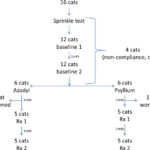Does your cat frequently experience vomiting or hairballs? It might surprise you to learn that hairballs are not a normal occurrence for cats. Their bodies are designed to naturally process and eliminate ingested hair through grooming. Persistent hairballs, alongside vomiting, could indicate your cat’s sensitivity to something in their diet.
Gastrointestinal (GI) issues in cats are often triggered by food that’s hard to digest, allergies to food, or artificial additives like flavorings and preservatives. Switching to a diet specifically formulated for sensitive stomachs can often alleviate or even resolve these problems. However, it’s crucial to consult your veterinarian before making any changes to your cat’s diet.
If you suspect your cat has a sensitive stomach, here’s how to determine the cause and find the most suitable diet to help them feel better.
Recognizing a Sensitive Stomach in Your Cat
Vomiting can be a symptom of various health issues, not just food sensitivities. Similarly, coughing up a hairball can resemble other respiratory issues like feline asthma.
If your cat vomits food or hairballs more than once a month, or if they are also losing weight, it’s essential to schedule a visit with your veterinarian. Capturing a video of these episodes at home can provide valuable insights for your vet during the consultation.
During a veterinary examination, your vet will look for clues to identify the cause of your cat’s stomach upset. Diagnostic tests, such as blood work, X-rays, or ultrasounds, might be recommended to pinpoint the underlying cause of the GI distress. Ruling out other medical conditions is crucial to ensure your cat receives the appropriate treatment for any underlying health issues.
How to Choose the Right Cat Food for Sensitive Stomachs
Once other health problems are excluded, collaborate with your veterinarian to determine the best cat food for your cat’s sensitive stomach. Your vet can guide you toward foods that meet your cat’s specific nutritional needs, while you can consider your cat’s preferences to find a food they will enjoy.
Here are some strategies your veterinarian might suggest when searching for suitable cat food for sensitive stomachs.
Initiate a Diet Trial
After your cat receives a clean bill of health, a diet trial is the next logical step. This process involves systematically trying different cat foods to pinpoint one that agrees with your cat’s sensitive stomach. No single diet works universally for all cats; each cat will react uniquely to different foods. Therefore, working closely with your veterinarian is key to finding the most appropriate diet tailored to your cat’s individual needs.
Allow a sufficient period, potentially three to four months, for your cat to fully adjust to a new diet. This duration allows for the old diet to clear from their system, enabling a comprehensive evaluation of the new food’s effectiveness.
Key Ingredients to Look for in Cat Food for Sensitive Stomachs
The best cat foods for sensitive stomachs are typically highly digestible and free from potential irritants. Highly digestible formulas usually contain moderate to low levels of fat, moderate protein, and moderate carbohydrates. Many of these specialized diets include additives that promote intestinal health, such as soluble fiber, omega-3 fatty acids, and increased antioxidant vitamins. They are also often formulated without common irritants like gluten, lactose, artificial food colorings, or preservatives.
Consider Hypoallergenic Cat Food Options
Food allergies are a common cause of gastrointestinal upset in cats. Among dietary components, protein sources are the most frequent culprits behind food allergies. Cats can develop allergies to any protein they’ve been exposed to. For instance, a cat might be allergic to both rabbit and chicken. However, if a cat has never consumed rabbit before, their immune system is unlikely to have developed a sensitivity to it, making an allergic reaction less probable.
Research indicates that beef, chicken, and fish are among the proteins most frequently associated with food allergies in cats. For cats with known or suspected protein sensitivities, hypoallergenic diets are often the best cat food choice.
Types of Hypoallergenic Diets for Cats
Hypoallergenic cat diets come in three main categories:
-
Limited Ingredient Diets: These diets typically feature a single protein source and a single carbohydrate source, and are often available over-the-counter. An example is Natural Balance® L.I.D. Chicken & Green Pea Formula grain-free canned cat food. However, it’s important to note that these diets are not always strictly regulated to prevent cross-contamination during manufacturing.
-
Veterinary Prescription Diets with Novel Protein: For cats with more pronounced allergies, veterinary prescription diets containing novel proteins are recommended. These diets use a single, less common protein source and are produced in facilities designed to minimize cross-contamination.
-
Hydrolyzed Protein Diets: These prescription diets utilize a process called hydrolysis to break down proteins into smaller components, making them less likely to trigger an immune response. Royal Canin® Veterinary Diet Hydrolyzed Protein HP dry cat food is an example. These diets also require a veterinary prescription.
 Natural Balance L.I.D. Chicken & Green Pea Formula grain-free canned cat food
Natural Balance L.I.D. Chicken & Green Pea Formula grain-free canned cat food
Other Strategies to Support Cats with Sensitive Stomachs
Sometimes, managing your cat’s sensitive stomach can be as simple as adjusting the type of food or their feeding schedule.
Consider Changing the Form of Cat Food
If your cat has stomach sensitivities while eating dry food, switching to a high-protein, low-carbohydrate canned food diet might be beneficial. Options like Royal Canin® Veterinary Diet Gastrointestinal Moderate Calorie canned cat food or Purina® Pro Plan® Veterinary Diets EN Gastroenteric Formula canned cat food are worth considering.
Conversely, if your cat is currently on a wet food diet, transitioning to a dry food formulated for sensitive digestion, such as Royal Canin® Sensitive Digestion dry cat food, could be helpful.
 Royal Canin Sensitive Digestion dry cat food
Royal Canin Sensitive Digestion dry cat food
Modify the Feeding Routine
Cats that consume large meals at once are more prone to vomiting shortly after eating, a phenomenon sometimes referred to as “scarf and barf.” With their small stomachs, cats are naturally designed to eat frequent, small meals throughout the day, mimicking their natural hunting behavior. Providing one large bowl of food daily can overwhelm their digestive system and lead to regurgitation.
Smaller, more frequent meals are generally recommended. This approach reduces food retention in the stomach and enhances digestion and nutrient absorption. You can replicate this natural feeding pattern using tools like the Doc & Phoebe’s™ indoor hunting cat feeder kit. This kit encourages portion control, increases activity, and reduces stress, which can help decrease or eliminate vomiting. Instead of filling a bowl twice a day, you distribute food into the feeder mice and hide them, promoting a more natural and healthy eating habit.


